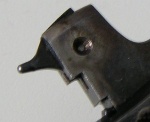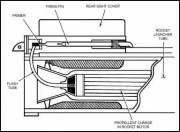Firing pin
A firing pin or striker is part of the firing mechanism used in a firearm or explosive device e.g. an M14 landmine or bomb fuze. Firing pins may take many forms, though the types used in landmines, bombs, grenade fuzes or other single-use devices generally have a sharpened point. In contrast, firing pins used in firearms usually have a small, rounded portion designed to strike the primer of a cartridge, detonating the priming compound, which then ignites the propellant.[1][2][3]
Contents[hide] |
Firing pin vs. striker
A firing pin is a lightweight part, which serves to transfer energy from a spring loaded hammer to the primer, while a striker is usually heavier, and is directly connected to the spring providing the energy to impact the primer. Strikers mechanisms are generally simpler, since they combine the functions of hammer and firing pin in one.[1]
The firing pin or striker is generally located in the bolt of a repeating firearm. Firearms that do not have bolts, such as revolvers and many types of single-shot actions, generally have a very short firing pin in the frame, or else attached to the hammer itself. These types of firearms are almost never striker fired, as there is insufficient space to house a striker mechanism. Strikers are most commonly found in pistols and bolt action firearms.[1]
Firing pin construction

Firearms that use long firing pins, such as pistols, will often use a firing pin that is too short to project when depressed flush by the hammer. This type of firing pin, called an inertial firing pin, must be struck by a full fall of the hammer to provide the momentum to move forward and strike the primer. If the hammer is down, resting on the firing pin, it is very unlikely that a blow to the rear will provide enough energy to the firing pin to detonate the primer. Most variants of the M1911 pistol use this type of firing pin.[2]
Many firing pins are stamped from sheet steel, forming a rectangular cross-section rather than a round one. These will often have a cylindrical section at the front rather than a hemispherical one, and are fairly common in rimfire firearms. Sturm, Ruger, for example, uses sheet metal firing pins in its 10/22 carbine and Mark II pistol.
High performance firing pins are often made from lighter materials than steel, such as titanium. The ligher material increases the speed at which the firing pin travels, and reduces the lock time, or the time from trigger pull to the bullet leaving the barrel. See accurize for more information.
Striker construction
Strikers are basically spring-loaded firing pins, generally of a one or two piece construction. In the one piece striker, the striker is turned on a lathe out of a round bar of metal, much larger in diameter than a firing pin, to provide the mass required to detonate the primer. Two piece strikers generally consist of a firing pin attached to a heavier rear section--in essence a hammer attached to the base of a firing pin. Two piece strikers are commonly found on bolt action rifles, while single piece strikers are found on pistols, such as those made by Glock.[3]
Other uses
Mechanisms involving firing pins can be used also in other pyrotechnical systems, ranging from hand grenades to chemical oxygen generators.References
- ↑ 1.0 1.1 1.2 XD X-Deelicious! Charles E. Petty American Cop
- ↑ 2.0 2.1 SAAMI Glossary, F, SAAMI
- ↑ 3.0 3.1 SAAMI Glossary, S, SAAMI
- ↑ Definition of "transfer bar" MidwayUSA GunTec Dictionary

